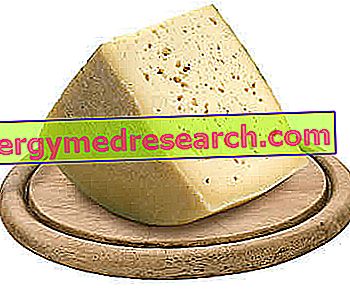Generality
Montasio is a dairy product similar to Latteria, Carnia and Friulano.
It is a typical cheese of Northern Italy.

The name "montasio" is related to the typical origin of the Alpine group of the Julian Alps, rich in pastures that have always been exploited for mountain pastures.
The motasio is one of the most exported cheeses abroad.
Nutritional Features
| Chemical composition | Value for 100g | |
| Edible part | 100% | |
| water | 32, 0g | |
| Protein | 30, 3g | |
| Total lipids | 31, 5g | |
| Saturated fatty acids | 19, 98g | |
| Monounsaturated fatty acids | 10, 42g | |
| Polyunsaturated fatty acids | 1, 14g | |
| Cholesterol | 100, 0mg | |
| Carbohydrates available | 2.0g | |
| Starch | 0.0g | |
| Soluble sugars | 2.0g | |
| Total fiber | 0.0g | |
| Soluble fiber | 0.0g | |
| Insoluble fiber | 0.0g | |
| Phytic acid | 0.0g | |
| Alcohol | 0.0g | |
| Power | 412, 2kcal | |
| Sodium | 757, 0mg | |
| Potassium | 99, 0mg | |
| Iron | 0, 30mg | |
| Football | 950, 0mg | |
| Phosphorus | 610, 0mg | |
| Magnesium | - mg | |
| Zinc | 2, 30mg | |
| Copper | - mg | |
| Selenium | - µg | |
| Thiamine | 0, 03mg | |
| Riboflavin | 0, 39mg | |
| Niacin | 0, 00mg | |
| Vitamin A retinol eq. | 363.0 RAE | |
| C vitamin | 2, 00mg | |
| Vitamin E | 0, 58mg | |
Montasio is a product that belongs to the II fundamental group of foods (milk and derivatives).
Its nutritional function is above all to provide proteins rich in essential amino acids, calcium and vitamin B2.
It is considered a medium-light cheese, since (in the context of cheeses) the fat intake is just below the average. Nevertheless, it still represents a fairly caloric food.
Energy comes mainly from lipids, followed by proteins and finally traces of carbohydrates.
The fatty acids of montasio are mainly saturated, peptides with high biological value and simple sugars (lactose).
Among the vitamins, the concentrations of water-soluble riboflavin (B2) and liposoluble A (retinol) stand out.
As far as mineral salts are concerned, calcium, phosphorus and sodium levels stand out.
The cholesterol level is considerable.
Does not contain fibers.
It is gluten-free but contains small concentrations of lactose which, in case of hypersensitivity (severe intolerance), can create various problems (diarrhea, abdominal pain, meteorism, vomiting, etc.).
On the other hand, it has the characteristic of being well tolerated even by subjects with intestinal diseases.
In medicine, the use of montasio (and few other milk derivatives, such as grain) is known in the diet of convalescent people due to infectious complications of the digestive system.
Excessive consumption of montasio is not recommended in case of overweight and hypercholesterolemia.
Thanks to the concentration of calcium and phosphorus, this cheese is recommended in the diet of subjects who require a significant contribution of these minerals (growing subjects, menopause etc.).
On the other hand, the excess of sodium makes montasio totally unsuitable for the diet of hypertension.
The average portion of montasio is about 80 g (330 kcal).
Description
Montasio is a cheese made exclusively from cow's milk.
It is produced with a semi-cooked paste, pressed, which becomes semi-hard or lasts depending on the seasoning.
There are mainly 3 types of montasio:
- Semi hard, matured for a few months (prevalence of the product).
- Typical of alp, hard, with 5-12 months seasoning.
- Tough, to be scratched, aged for over 12 months (very old).
WARNING! The following is referred to the semi-hard montasio, matured for a few months.
The cheese is packaged in large pieces of cylindrical shape, with a low heel of 6-10 cm and a weight of between 5-9 kg.
It has a smooth, regular and flexible rind.
It has a light yellow (straw) color and a tenacious consistency, but quite elastic. It shows some small evenly scattered holes, called "a bird's eye" (by heterolactic bacteria).
On the palate, the montasio is medium salty and quite tasty.
Contains 36-43% of fat (calculated on the dry substance), 35-45% of water, 0.5-1.0% of lactose (shows an average lactase activity), 0.5-1., 0% calcium.
It has a proteolysis index of 12-15 and one of lipolysis which is around 5.
The pH is 5.2 at the beginning of maturation and 6 at the end of maturation.
Outline of Production
The production of montasio is quite faithful to that of other Alpine cheeses.
A freshly milked milk or a mixture of semi-skimmed milk (from evening milking) and whole milk (from morning milking) is used.
In the past the grafting-whey of natural crops was used; today this happens only in artisanal productions, while at the industrial level selected lactic ferments are preferred.
The curd is broken, cut into small pieces and kept stirring.
When the mass becomes consistent, it is heated by direct fire or steam until it reaches a temperature of 48-50 ° C.
The curd is left to settle in the bottom and the serum is extracted by filtering everything with sheets.
The solid mass is distributed in the molds placed under press to speed up the drainage of the residual whey (also favored by acidification).
The cheese is then subjected to salting.
The forms are then detached in the casere for the seasoning.
The latter is prolonged for 2-6 months at a temperature of 10-15 ° C.
Gastronomic outline
As for the gastronomic aspect, montasio is a typical table cheese, although the one aged over a year (stravecchio) lends itself to being grated over pasta or risotto.
Risotto with pears and cheese
X Problems with video playback? Reload from YouTube Go to Video Page Go to Video Recipes Section Watch the video on youtubeEven if it is not part of the specification, it is necessary to mention the seasoned montasio in the must of merlot and cabernet wine, called “ formaio embriago ”. In a few days this product reaches a maturation level of several months.
The recommended wine pairings for montasio are with:
- Rosato delle Gravi friulane.
- Merlot del Collio.
- Red Riviera del Garda.
- Rosso Terre di Franciacorta.
- Teroldego Rotaliano.
- Sassicaia.
NB . The oenological combination depends on the seasoning level.



